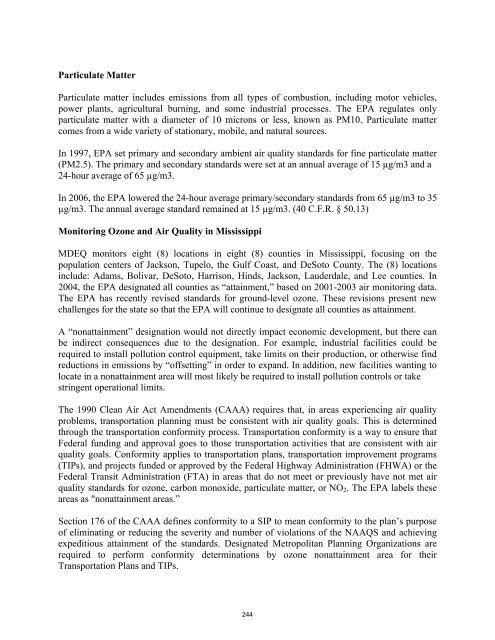in Mississippi
m2078-county-gov-ms
m2078-county-gov-ms
Create successful ePaper yourself
Turn your PDF publications into a flip-book with our unique Google optimized e-Paper software.
Particulate Matter<br />
Particulate matter <strong>in</strong>cludes emissions from all types of combustion, <strong>in</strong>clud<strong>in</strong>g motor vehicles,<br />
power plants, agricultural burn<strong>in</strong>g, and some <strong>in</strong>dustrial processes. The EPA regulates only<br />
particulate matter with a diameter of 10 microns or less, known as PM10. Particulate matter<br />
comes from a wide variety of stationary, mobile, and natural sources.<br />
In 1997, EPA set primary and secondary ambient air quality standards for f<strong>in</strong>e particulate matter<br />
(PM2.5). The primary and secondary standards were set at an annual average of 15 µg/m3 and a<br />
24-hour average of 65 µg/m3.<br />
In 2006, the EPA lowered the 24-hour average primary/secondary standards from 65 µg/m3 to 35<br />
µg/m3. The annual average standard rema<strong>in</strong>ed at 15 µg/m3. (40 C.F.R. § 50.13)<br />
Monitor<strong>in</strong>g Ozone and Air Quality <strong>in</strong> <strong>Mississippi</strong><br />
MDEQ monitors eight (8) locations <strong>in</strong> eight (8) counties <strong>in</strong> <strong>Mississippi</strong>, focus<strong>in</strong>g on the<br />
population centers of Jackson, Tupelo, the Gulf Coast, and DeSoto County. The (8) locations<br />
<strong>in</strong>clude: Adams, Bolivar, DeSoto, Harrison, H<strong>in</strong>ds, Jackson, Lauderdale, and Lee counties. In<br />
2004, the EPA designated all counties as “atta<strong>in</strong>ment,” based on 2001-2003 air monitor<strong>in</strong>g data.<br />
The EPA has recently revised standards for ground-level ozone. These revisions present new<br />
challenges for the state so that the EPA will cont<strong>in</strong>ue to designate all counties as atta<strong>in</strong>ment.<br />
A “nonatta<strong>in</strong>ment” designation would not directly impact economic development, but there can<br />
be <strong>in</strong>direct consequences due to the designation. For example, <strong>in</strong>dustrial facilities could be<br />
required to <strong>in</strong>stall pollution control equipment, take limits on their production, or otherwise f<strong>in</strong>d<br />
reductions <strong>in</strong> emissions by “offsett<strong>in</strong>g” <strong>in</strong> order to expand. In addition, new facilities want<strong>in</strong>g to<br />
locate <strong>in</strong> a nonatta<strong>in</strong>ment area will most likely be required to <strong>in</strong>stall pollution controls or take<br />
str<strong>in</strong>gent operational limits.<br />
The 1990 Clean Air Act Amendments (CAAA) requires that, <strong>in</strong> areas experienc<strong>in</strong>g air quality<br />
problems, transportation plann<strong>in</strong>g must be consistent with air quality goals. This is determ<strong>in</strong>ed<br />
through the transportation conformity process. Transportation conformity is a way to ensure that<br />
Federal fund<strong>in</strong>g and approval goes to those transportation activities that are consistent with air<br />
quality goals. Conformity applies to transportation plans, transportation improvement programs<br />
(TIPs), and projects funded or approved by the Federal Highway Adm<strong>in</strong>istration (FHWA) or the<br />
Federal Transit Adm<strong>in</strong>istration (FTA) <strong>in</strong> areas that do not meet or previously have not met air<br />
quality standards for ozone, carbon monoxide, particulate matter, or NO 2 . The EPA labels these<br />
areas as "nonatta<strong>in</strong>ment areas.”<br />
Section 176 of the CAAA def<strong>in</strong>es conformity to a SIP to mean conformity to the plan’s purpose<br />
of elim<strong>in</strong>at<strong>in</strong>g or reduc<strong>in</strong>g the severity and number of violations of the NAAQS and achiev<strong>in</strong>g<br />
expeditious atta<strong>in</strong>ment of the standards. Designated Metropolitan Plann<strong>in</strong>g Organizations are<br />
required to perform conformity determ<strong>in</strong>ations by ozone nonatta<strong>in</strong>ment area for their<br />
Transportation Plans and TIPs.<br />
244


